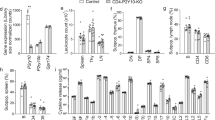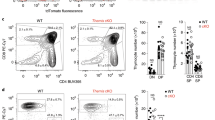Abstract
We describe a protein with the hallmarks of a chemokine, designated CXCL16, that is made by dendritic cells (DCs) in lymphoid organ T cell zones and by cells in the splenic red pulp. CXCL16 contains a transmembrane domain and both membrane-bound and soluble forms are produced. Naïve CD8 T cells, natural killer T cells and a subset of memory CD4 T cells bind CXCL16, and activated T cells migrated chemotactically to the soluble chemokine. By expression cloning, Bonzo (also known as STRL33 and TYMSTR) was identified as a CXCL16 receptor. CXCL16 may function in promoting interactions between DCs and CD8 T cells and in guiding T cell movements in the splenic red pulp. CXCL16 was also found in the thymic medulla and in some nonlymphoid tissues, indicating roles in thymocyte development and effector T cell trafficking.
This is a preview of subscription content, access via your institution
Access options
Subscribe to this journal
Receive 12 print issues and online access
$209.00 per year
only $17.42 per issue
Buy this article
- Purchase on Springer Link
- Instant access to full article PDF
Prices may be subject to local taxes which are calculated during checkout







Similar content being viewed by others
References
Oppenheim, J. J., Zachariae, C. O. C., Mukaida, J. & Matsushima, K. Properties of the novel proinflammatory supergene “intercrine” cytokine family. Annu. Rev. Immunol. 9, 617–648 (1991).
Cyster, J. G. Chemokines and cell migration in secondary lymphoid organs. Science 286, 2098–2102 (1999).
Zlotnik, A., Morales, J. & Hedrick, J. A. Recent advances in chemokines and chemokine receptors. Crit. Rev. Immunol. 19, 1–47 (1999).
Zlotnik, A. & Yoshie, O. Chemokines: a new classification system and their role in immunity. Immunity 12, 121–127 (2000).
Pan, Y. et al. Neurotactin, a membrane-anchored chemokine upregulated in brain inflammation Nature 387, 611–617 (1997). (Erratum: Nature 389, 100 (1997).)
Bazan, J. F. et al. A new class of membrane-bound chemokine with a CX3C motif. Nature 385, 640–644 (1997).
Baggiolini, M., Dewald, B. & Moser, B. Human chemokines: an update. Annu. Rev. Immunol. 15, 675–705 (1997).
Unutmaz, D., KewalRamani, V. N. & Littman, D. R. G. protein-coupled receptors in HIV and SIV entry: new perspectives on lentivirus-host interactions and on the utility of animal models. Semin. Immunol. 10, 225–236 (1998).
Pellas, T. C. & Weiss, L. Migration pathways of recirculating murine B cells and CD4+ and CD8+ T lymphocytes. Am. J. Anat. 187, 355–373 (1990).
Willfuhr, K. U. & Westermann, J. Absolute numbers of lymphocyte subsets migrating through the compartments of the normal and transplanted rat spleen. Eur. J. Immunol. 20, 903–911 (1990).
Potsch, C., Vohringer, D. & Pircher, H. Distinct migration patterns of naive and effector CD8 T cells in the spleen: correlation with CCR7 receptor expression and chemokine reactivity. Eur. J. Immunol. 29, 3562–3570 (1999).
Trinchieri, G. Biology of natural killer cells. Adv. Immunol. 47, 187–376 (1989).
Smith, K. G. C., Hewitson, T. D., Nossal, G. J. V. & Tarlinton, D. M. The phenotype and fate of the antibody-forming cells of the splenic foci. Eur. J. Immunol. 26, 444–448 (1996).
Liao, F. et al. STRL33, a novel chemokine receptor-like protein, functions as a fusion cofactor for both macrophage-tropic and T cell line-tropic HIV-1. J. Exp. Med. 185, 2015–2023 (1997).
Deng, H. K., Unutmaz, D., KewalRamani, V. N. & Littman, D. R. Expression cloning of new receptors used by simian and human immunodeficiency viruses. Nature 388, 296–300 (1997).
Loetscher, M. et al. TYMSTR, a putative chemokine receptor selectively expressed in activated T cells, exhibits HIV-1 coreceptor function. Curr. Biol. 7, 652–660 (1997).
Hofmann, K., Bucher, P., Falquet, L. & Bairoch, A. The PROSITE database, its status in 1999. Nucleic Acids Res. 27, 215–219 (1999).
Cyster, J. G., Shotton, D. M. & Williams, A. F. The dimensions of the T lymphocyte glycoprotein leukosialin and identification of linear protein epitopes that can be modified by glycosylation. EMBO J. 10, 893–902 (1991).
Abdullah, K. M., Udoh, E. A., Shewen, P. E. & Mellors, A. A neutral glycoprotease of Pasteurella haemolytica A1 specifically cleaves O-sialoglycoproteins. Infect. Immun. 60, 56–62 (1992).
Hooper, N. M., Karran, E. H. & Turner, A. J. Membrane protein secretases. Biochem. J. 321, 265–279 (1997).
Edinger, A. L. et al. Use of GPR1, GPR15, and STRL33 as coreceptors by diverse human immunodeficiency virus type 1 and simian immunodeficiency virus envelope proteins. Virology 249, 367–378 (1998).
Ngo, V. N., Tang, H. L. & Cyster, J. G. Epstein-Barr virus-induced molecule 1 ligand chemokine is expressed by dendritic cells in lymphoid tissues and strongly attracts naive T cells and activated B cells. J. Exp. Med. 188, 181–191 (1998).
Sallusto, F. et al. Distinct patterns and kinetics of chemokine production regulate dendritic cell function. Eur. J. Immunol. 29, 1617–1625 (1999).
Tang, H. L. & Cyster, J. G. Chemokine upregulation and activated T cell attraction by maturing dendritic cells. Science 284, 819–822 (1999).
Papadopoulos, E. J. et al. Fractalkine, a CX3C chemokine, is expressed by dendritic cells and is up-regulated upon dendritic cell maturation. Eur. J. Immunol. 29, 2551–2559 (1999).
Kanazawa, N. et al. Fractalkine and macrophage-derived chemokine: T cell-attracting chemokines expressed in T cell area dendritic cells. Eur. J. Immunol. 29, 1925–1932 (1999).
Lanzavecchia, A. License to kill. Nature 393, 413–414 (1998).
Ridge, J. P., Di Rosa, F. & Matzinger, P. A conditioned dendritic cell can be a temporal bridge between a CD4+ T-helper and a T-killer cell. Nature 393, 474–478 (1998).
Haanen, J. B. et al. Systemic T cell expansion during localized viral infection. Eur. J. Immunol. 29, 1168–1174 (1999).
Ohmori, Y. et al. Tumor necrosis factor-alpha induces cell type and tissue-specific expression of chemoattractant cytokines in vivo. Am. J. Pathol. 142, 861–870 (1993).
Amichay, D. et al. Genes for chemokines MuMig and Crg-2 are induced in protozoan and viral infections in response to IFN-γ with patterns of tissue expression that suggest nonredundant roles in vivo. J. Immunol. 157, 4511–4520 (1996).
Bordessoule, D., Gaulard, P. & Mason, D. Y. Preferential localisation of human lymphocytes bearing γδ T cell receptors to the red pulp of the spleen. J. Clin. Pathol. 43, 461–464 (1990).
Balazs, M., Grama, L. & Balogh, P. Detection of phenotypic heterogeneity within the murine splenic vasculature using rat monoclonal antibodies IBL-7/1 and IBL-7/22. Hybridoma 18, 177–182 (1999).
Muehlhoefer, A. et al. Fractalkine is an epithelial and endothelial cell-derived chemoattractant for intraepithelial lymphocytes in the small intestinal mucosa. J. Immunol. 164, 3368–3376 (2000).
Bendelac, A., Rivera, M. N., Park, S. H. & Roark, J. H. Mouse CD1-specific NK1 T cells: development, specificity, and function. Annu. Rev. Immunol. 15, 535–562 (1997).
Alkhatib, G., Liao, F., Berger, E. A., Farber, J. M. & Peden, K. W. A new SIV co-receptor, STRL33 (letter; see comments). Nature 388, 238 (1997).
Pohlmann, S., Krumbiegel, M. & Kirchhoff, F. Coreceptor usage of BOB/GPR15 and Bonzo/STRL33 by primary isolates of human immunodeficiency virus type 1. J. Gen. Virol. 80, 1241–1251 (1999).
Zhang, Y. J. & Moore, J. P. Will multiple coreceptors need to be targeted by inhibitors of human immunodeficiency virus type 1 entry? J. Virol. 73, 3443–3448 (1999).
Van Vactor, D. V. & Lorenz, L. J. Neural development: the semantics of axon guidance. Curr. Biol. 9, R201–204 (1999).
Holder, N. & Klein, R. Eph receptors and ephrins: effectors of morphogenesis. Development 126, 2033–2044 (1999).
Reif, K., Nobes, C. D., Thomas, G., Hall, A. & Cantrell, D. A. Phosphatidylinositol 3-kinase signals activate a selective subset of Rac/Rho-dependent effector pathways. Curr. Biol. 6, 1445–1455 (1996).
Lane, P. et al. Activated human T cells express a ligand for the human B cell-associated antigen CD40 which participates in T cell-dependent activation of B lymphocytes. Eur. J. Immunol. 22, 2573–2578 (1992).
Acknowledgements
We thank P. Hyman for technical help, P. Lane for the Fc expression plasmid, C. Turck for protein sequencing, A. Weiss for helpful input and L. Mintz for comments on the manuscript. Supported by NIH grant AI45073 and Packard Foundation (to J. G. C.) and UCSF Molecular Medicine Training Program and NIH Academic Rheumatology and Clinical Immunology training grant AR07304 (to M. M.).
Author information
Authors and Affiliations
Corresponding author
Rights and permissions
About this article
Cite this article
Matloubian, M., David, A., Engel, S. et al. A transmembrane CXC chemokine is a ligand for HIV-coreceptor Bonzo. Nat Immunol 1, 298–304 (2000). https://doi.org/10.1038/79738
Received:
Accepted:
Issue Date:
DOI: https://doi.org/10.1038/79738
This article is cited by
-
Unleashing the potential of combining FGFR inhibitor and immune checkpoint blockade for FGF/FGFR signaling in tumor microenvironment
Molecular Cancer (2023)
-
Associations of tissue damage induced inflammatory plasticity in masseter muscle with the resolution of chronic myalgia
Scientific Reports (2023)
-
TLR7-MyD88-DC-CXCL16 axis results neutrophil activation to elicit inflammatory response in pustular psoriasis
Cell Death & Disease (2023)
-
Identification of CXCL16 as a diagnostic biomarker for obesity and intervertebral disc degeneration based on machine learning
Scientific Reports (2023)
-
Targeting CXCL16 and STAT1 augments immune checkpoint blockade therapy in triple-negative breast cancer
Nature Communications (2023)



